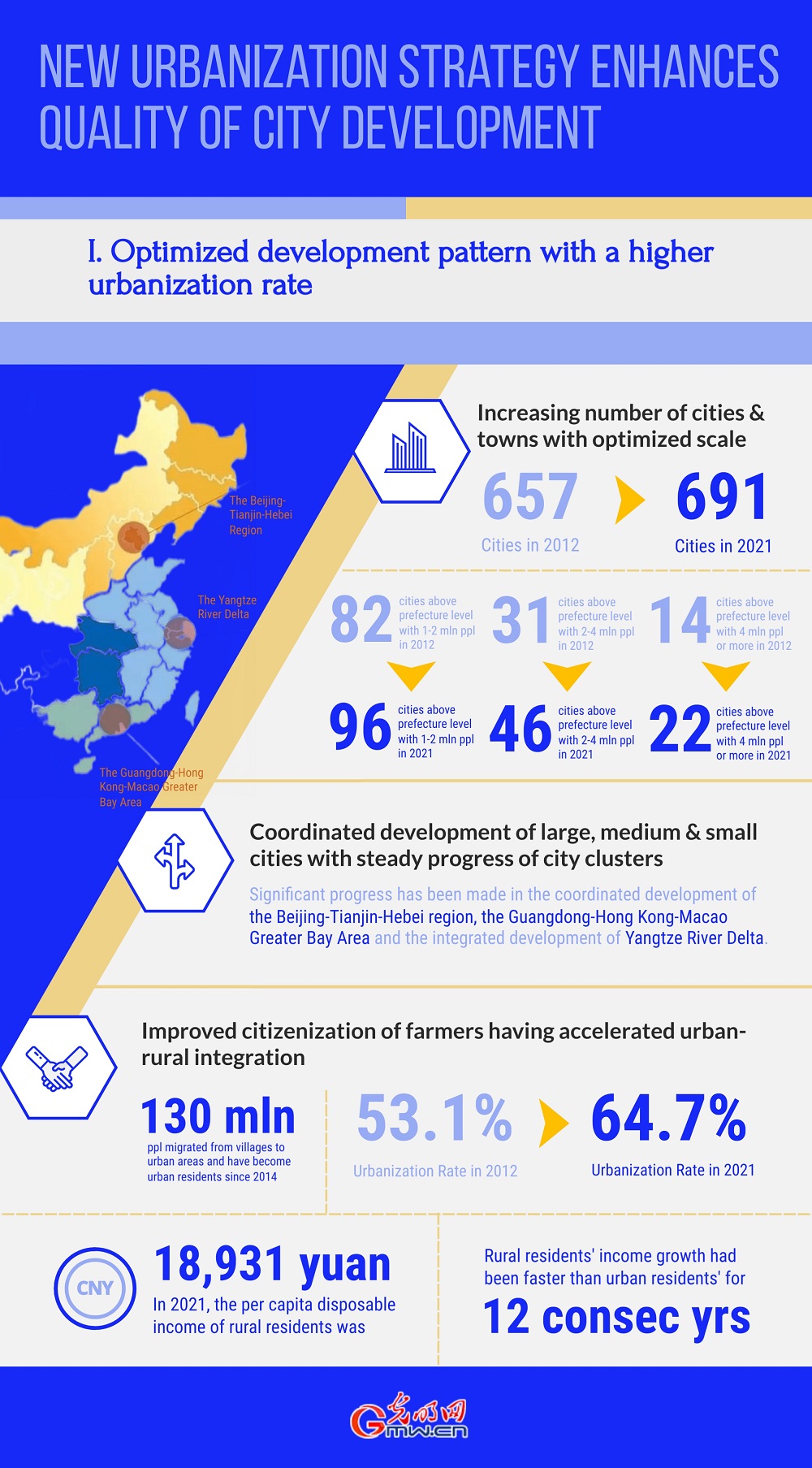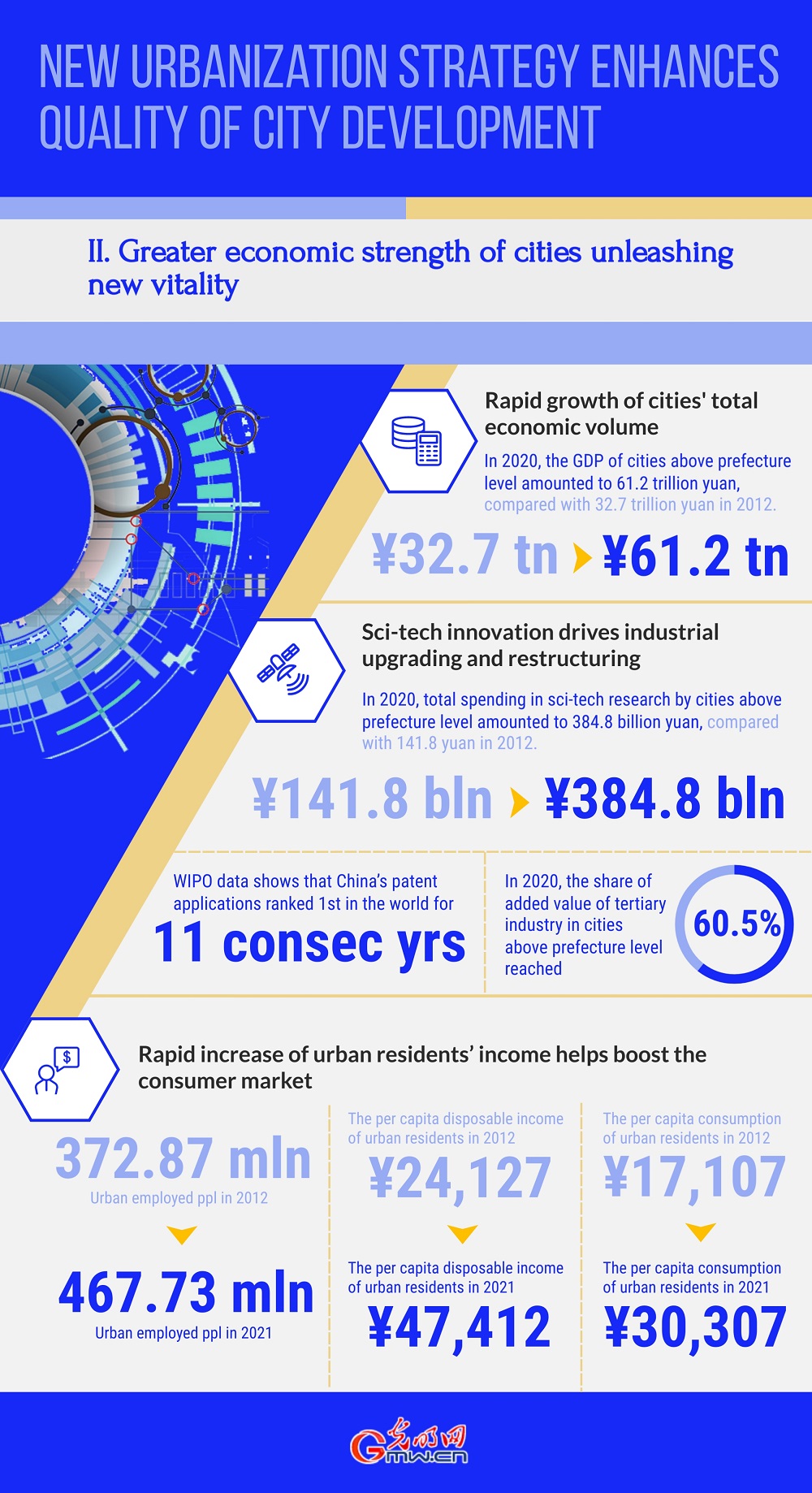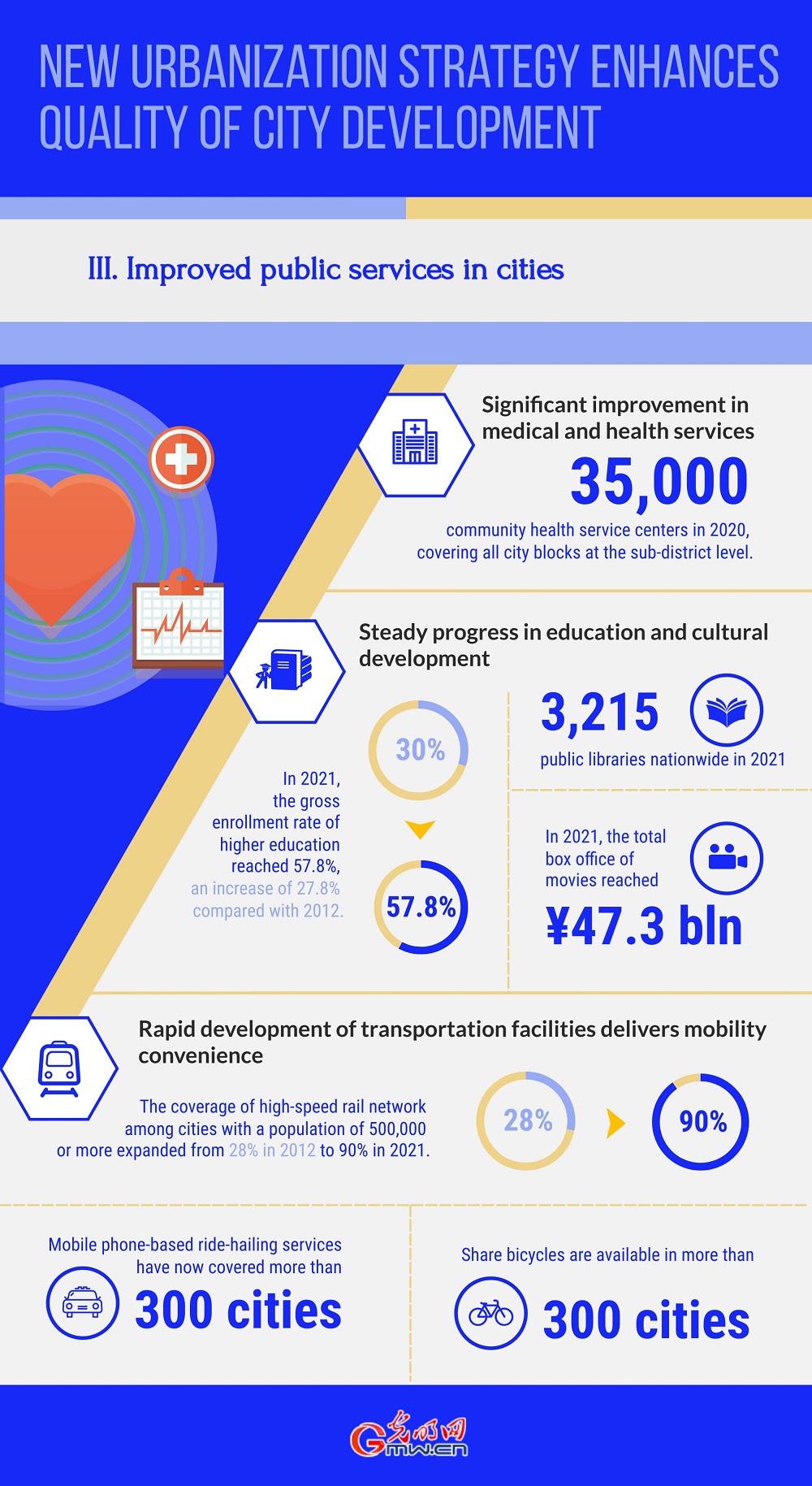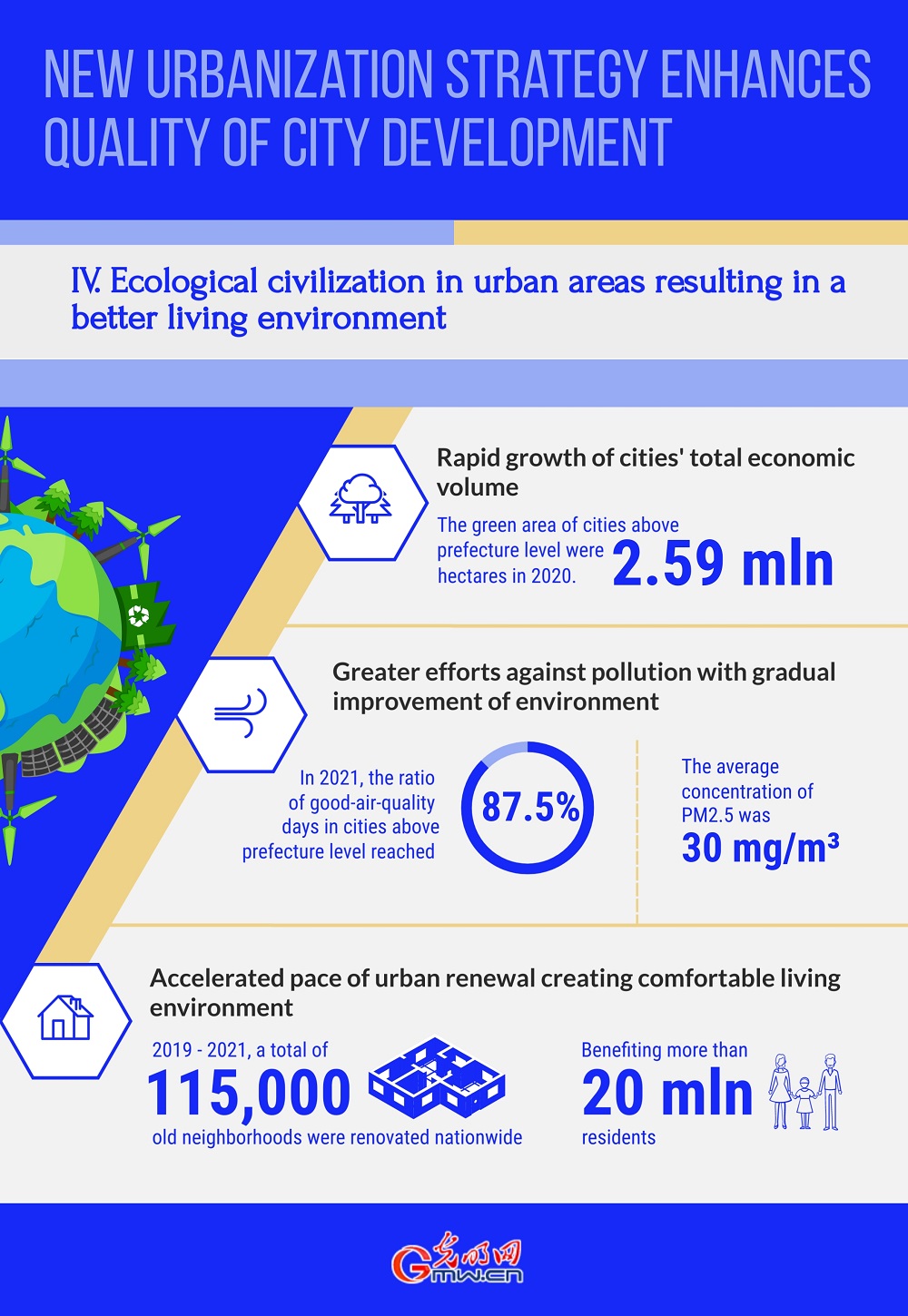By Wang Xinyuan
Since the 18th National Congress of the CPC, the Party Central Committee with Comrade Xi Jinping at its core has attached great importance to cities and proposed the new urbanization strategy that is people-centered and quality-oriented. The new urbanization strategy serves as a guidance for historic achievement of city development in the new era, helping to unleash cities’ potential and vitality. Chinese cities across the country have continuously improved their public services, living environment, and development quality.
I. Optimized development pattern with a higher urbanization rate

1. Increasing number of cities and towns with an optimized scale
As of end 2021, there were 691 cities across the country, 34 more than the end of 2012. Among them, 297 cities were above prefecture level, an increase of 8; there were also 394 county-level cities, an increase of 26 over 2012. The scale of urban population is expanding. According to the surveyed population at the end of 2020, there were 96, 46 and 22 cities above prefecture level with a population of 1-2 million, 2-4 million and 4 million or more respectively, which was 14, 15 and 8 more than the end of 2012.
2. Coordinated development of large, medium, and small cities with steady progress of city clusters
China has made important headways in building city clusters. The overall layout of “19+2” city clusters has been established, significant progress has been made in the coordinated development of the Beijing-Tianjin-Hebei region, the Guangdong-Hong Kong-Macao Greater Bay Area and the integrated development of Yangtze River Delta, the Chengdu-Chongqing region has entered the fast lane of growth, and the agglomeration of cities in the middle reaches of Yangtze River, Beibu Gulf and Guanzhong Plain has been steadily enhanced.
3. Improved citizenization of farmers has accelerated urban-rural integration
Since 2014, 130 million people migrated from villages to urban areas and have become urban residents. As of end 2021, the urbanization rate of China had reached 64.7%, 11.6 percentage points higher than that of the end of 2012.
The income gap between urban and rural residents continues to narrow. In 2021, the per capita disposable income of rural residents was 18,931 yuan, up 9.7% year-on-year in real terms, 2.6 percentage points faster than the income growth of urban residents, and the income growth of rural residents had been faster than that of urban residents for 12 consecutive years.
II. Greater economic strength of cities unleashing new vitality

1. Rapid growth of total economic volume resulted in greater financial strength of the government
In 2020, the regional GDP of cities above prefecture level amounted to 61.1713 trillion yuan (at current prices, the same below), compared with only 32.7382 billion yuan in 2012. The club of cities with a GDP larger than 1 trillion yuan has constantly expanded. In 2012, there were only 7 cities in the club, but in 2021, the number increased to 24.
2. Sci-tech innovation drives industrial upgrading and restructuring
In 2020, total spending in sci-tech research by cities above prefecture level amounted to RMB 384.8 billion, accounting for 4.1% of the public budget expenditure, compared with only RMB 141.8 billion in 2012, accounting for 3.2%; 3.42 million patents were granted, compared with only 1.13 million in 2012. The World Intellectual Property Organization (WIPO) data shows that China’s patent applications ranked first in the world for 11 consecutive years.
In 2020, the share of added value of tertiary industry in cities above prefecture level reached 60.5%. In 2021, the share of added value of high-tech manufacturing industry in the total added value of industrial enterprises above designated size hit 15.1%; up 5.7 percentage points compared with 2012.
3. Rapid increase of urban residents’ income helps boost the consumer market
The number of urban employed increased from 372.87 million in 2012 to 467.73 million in 2021. The per capita disposable income of urban residents increased from RMB 24,127 in 2012 to RMB 47,412 in 2021, with an average annual growth of 5.7% in real terms.
The per capita consumption of urban residents increased from 17,107 yuan in 2012 to 30,307 yuan in 2021, with an average annual real growth of 4.4%; the Engel coefficient of urban households was 28.6%, 3.4 percentage points lower than that in 2012.
III. Improved public services in cities

1. Significant improvement in medical and health services with a sound social security system
In 2020, medical and health expenditure in cities above prefecture level amounted to 850.3 billion yuan, 2.2 times more than in 2012. Allocation of medical resources became more optimized, in 2020, the number of community health service centers (stations) increased to 35,000, covering all city blocks at the sub-district level.
In 2020, social security and job-insurance expenditures in cities above prefecture level amounted to 1.169 billion yuan, an increase of 149.3% over 2012; housing security expenditures amounted to 339.9 billion yuan, an increase of 117% over 2012; At the end of 2020, the number of urban workers covered by basic pension insurance, basic medical insurance and unemployment insurance in cities above prefecture level reached 237.49 million, 289.72 million and 140.1 million respectively, up 46.2%, 14.1% and 41.6% over 2012.
2. Steady progress in education and cultural development
In 2020, the expenditure on education in cities above prefecture level reached 1.5081 trillion yuan, up 96.2% compared with 2012. In 2021, the gross enrollment rate of higher education reached 57.8%, an increase of 27.8 percentage points compared with 2012.
In 2020, the expenditure on culture, sports and public media in cities above prefectural level reached 185.3 billion yuan, an increase of 109.3% over 2012. As of end 2021, there were 3,215 public libraries nationwide, 139 more than the end of 2012. In 2021, the total box office of movies reached 47.3 billion yuan, and the number of movie-goers in cities reached 1.17 billion.
3. Rapid development of transportation facilities delivers mobility convenience
Urban road construction has seen robust growth in recent years, at the end of 2020, there were 4.37 million kilometers of quality roads in cities above prefecture level, 140,000 kilometers of highways nationwide, and roads in urban areas had covered a total of 7.2 billion square meters of land, up 24.6%, 60.5% and 54.6% over 2012, respectively.
A multi-layered rail transit network is quickly being formed, the coverage of China’s railroad network among cities with a population of 200,000 or more expanded from 94% in 2012 to 99% in 2021, and the coverage of high-speed rail network among cities with a population of 500,000 or more expanded from 28% in 2012 to 90% in 2021.
The coverage of urban rail transit is gradually expanding, too. As of end 2021, there were 275 urban rail transit lines operated in 51 cities, with a total operational mileage of 8,736 km.
Transportation services are becoming more intelligent thanks to the integration of 5G, big data, and artificial intelligence and other emerging technologies. Mobile phone-based ride-hailing services have now covered more than 300 cities and share bicycles are available in more than 360 cities, providing more diversified and personalized mobility services.
IV. Ecological civilization in urban areas resulting in a better living environment

1. Green development leads to better quality of life in cities
It has now become the consensus of the entire CPC and the Chinese society that “lush mountains and lucid waters are mountains of gold and silver”. With this guiding philosophy, China entered a new era with the “beautiful China” initiative. At the end of 2020, the green area of cities above prefecture level were 2.59 million hectares, an increase of 38.2% compared with the end of 2012; among them, the green area of parks reached 640,000 hectares, up 48.6%. Urban waste recycling and renewable use system were quickly established. At the end of 2020, 46 key cities had built up the classification and treatment system for domestic waste, covering 96% residential community.
2. Greater efforts against pollution with gradual improvement of environmental quality
In 2020, cities above prefecture level spent 283 billion yuan on energy conservation and environmental protection, an increase of 134% over 2012. In 2021, the ratio of good-air-quality days in cities above prefecture level reached 87.5%, up 0.5 percentage points over the previous year, and the average concentration of PM2.5 was 30 micrograms per cubic meter, down 9.1% over the previous year.
3. Accelerated pace of urban renewal creating comfortable living environment
As China’s urbanization advances, urban development has shifted from large-scale incremental construction to quality enhancement and structural adjustment. Between 2019 and 2021, a total of 115,000 old neighborhoods were renovated nationwide, benefiting more than 20 million residents.
来源:光明网
编辑:姜姿
 时刻新闻
时刻新闻
